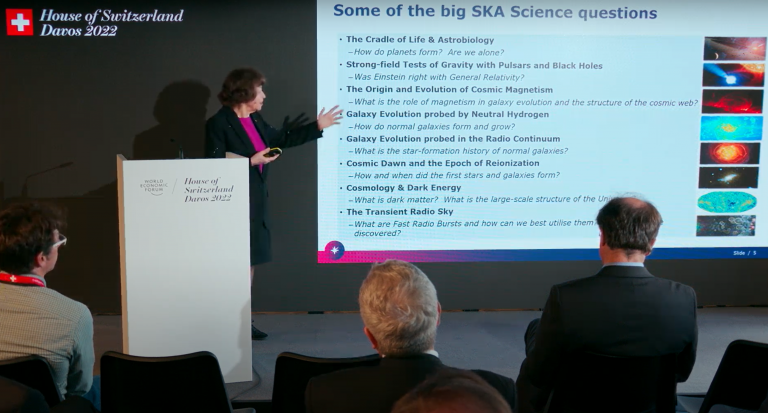Swiss formalises membership of SKA Observatory in Davos

Switzerland formalised its membership of the largest and most ambitious radio astronomy collaboration in the world – the SKA Observatory – at the House of Switzerland in Davos during the World Economic Forum.
Both the SKAO Council Chair, Dr Catherine Cesarsky, and Director-General, Prof. Philip Diamond, attended the media event. They were joined by key players involved in getting Switzerland on board the SKAO, including Martina Hirayama, State Secretary of the State Secretariat for Education, Research, and Innovation (SERI), Prof. Martin Vetterli, president of the École Polytechnique Fédérale de Lausanne (EPFL) university, and Jean-Paul Kneib, Swiss scientific delegate to the SKAO Council.
The Federal Council of Switzerland approved the country’s membership in the SKAO in December 2021. That step followed the Swiss Parliament’s decision to commit 33.6 million CHF towards the construction and operations of the SKA telescopes until 2030.
Switzerland intends to leverage industry and technical partners, providing expertise in the development of advanced receivers for dish antennas, but also in precision timing, automation, signal processing and Big Data. In exchange, Switzerland will gain access to the vast amounts of data (~710 PBytes/year) generated by the SKA telescopes for fundamental research as outlined in a 2020 whitepaper by the Swiss astrophysics community, including topics such as cosmology, dark energy, and astrobiology to name a few.
The participation of Switzerland in the construction and operation of SKAO also generates plentiful opportunities for Swiss high-tech companies to position themselves within this unique market. Switzerland also plans to further contribute to the development of the European SKA Regional Centre (SRC) to transform these data outputs into science products leading to an improved understanding of the Universe and of astrophysical processes. The Swiss branch of the SRC will also be the data interface for Swiss scientists.
Swiss involvement is organised through a strong consortium of research institutions*, called SKACH, in part funded by SERI. In the last five years, EPFL spearheaded Swiss involvement at the national level. Going forward this consortium will be led by a board that includes EPFL and a strong contingent of eight other institutions.
Watch the full event on YouTube.
* The Swiss partnership includes: Fachhochschule Nordwestschweiz (FHNW), Universität Zürich (UZH), Eidgenössische Technische Hochschule Zürich (ETHZ), Zürcher Hochschule für Angewandte Wissenschaften (ZHAW), Universität Basel (UniBAS), Université de Genève (UniGE), Haute École spécialisée de Suisse Occidentale (HES-SO), Centro Svizzero di Calcolo Scientifico (CSCS).
SKAO signs up software contributor in first Swiss contract
The SKAO signed its first contract with a Swiss contributor at the end of April to help build the software for its transformational telescopes. The contract with Cosylab forms part of the Observatory’s commitment to ensure that industries in the member countries benefit directly from their contribution to SKAO.
Cosylab, short for Control System Laboratory, is a leading provider of control systems for some of the world’s most complex projects, including the nuclear fusion project ITER in France and the particle accelerator CERN in Switzerland. Cosylab’s employees join other developers working on the SKA telescopes’ Observation Monitor and Controls software.
“Our Cosylab colleagues are very innovative and fit well with the SKAO’s collaborative and inclusive way of working,” said the Observatory’s Head of Computing and Software, Nick Rees. “This signing marks the final one in a series of 23 contracts valued at just under €100million to develop our telescopes’ software. It has been a long and complex process, so we are delighted with Cosylab capping off our effort.”
The first real-world test for the SKA software will be the deployment of 4 telescope dishes and 6 low-frequency antenna stations, scheduled for late 2023. The software should then be able to demonstrate some functionality for the control of the telescope, including basic interferometry.
By the time construction concludes at the end of the decade, the software in each telescope will need to transport and process an average of 8 terabits per second of data before distributing it to science users worldwide.




